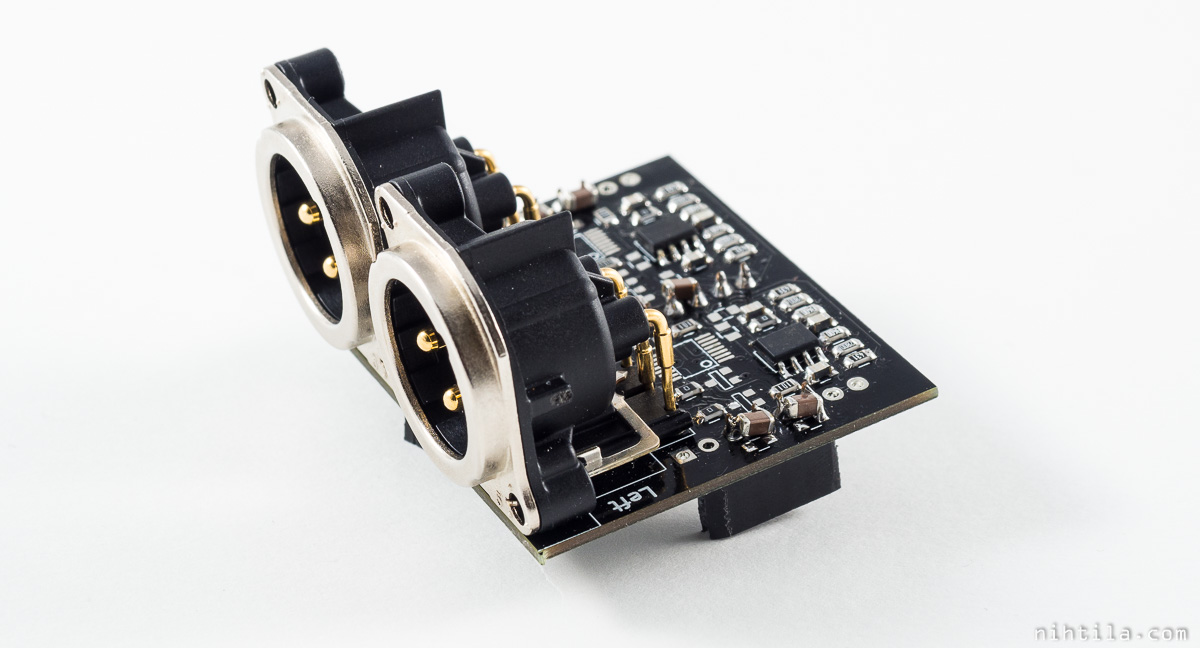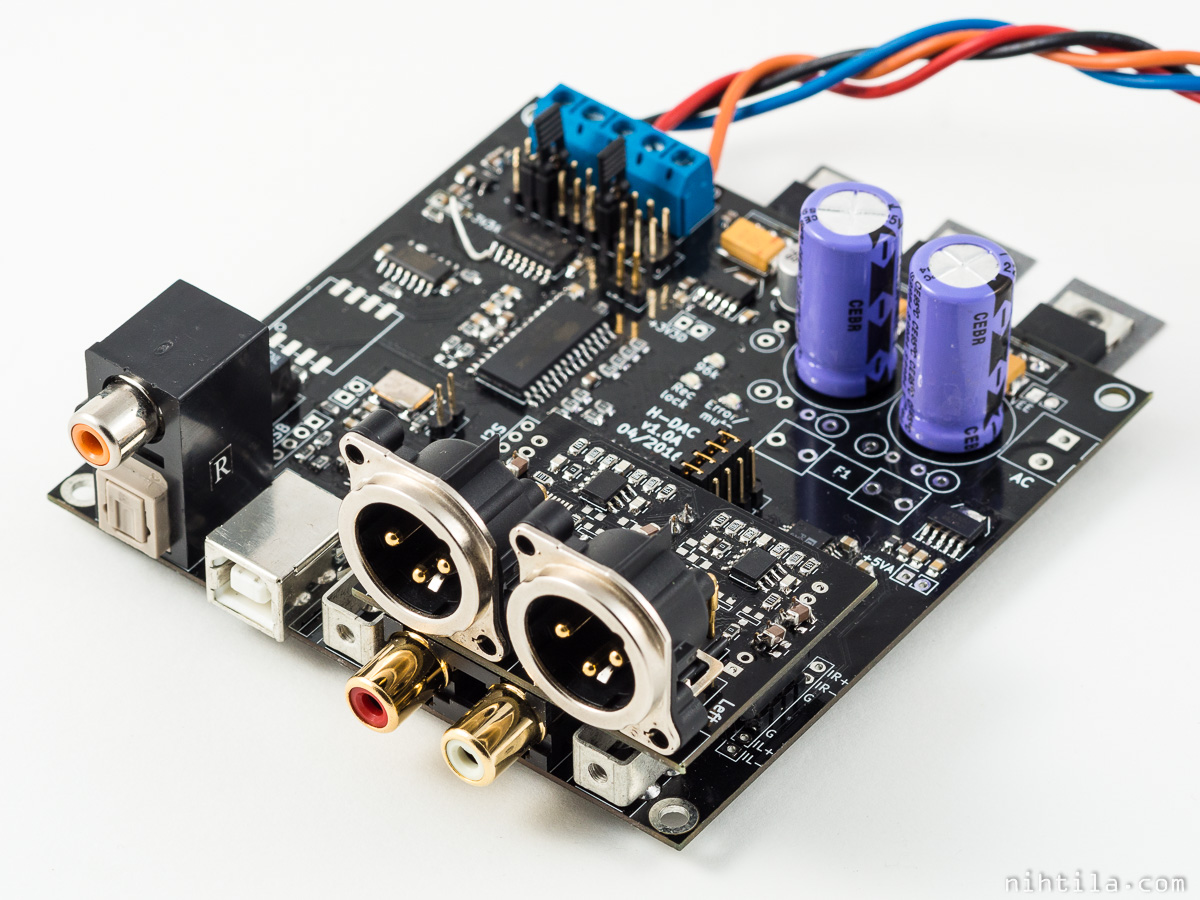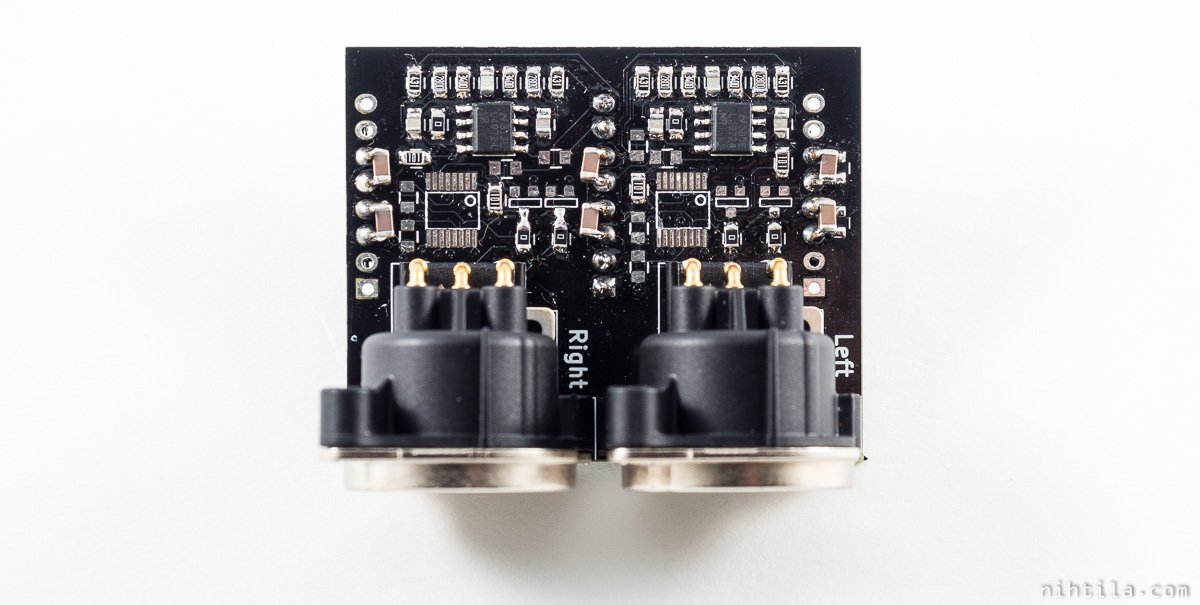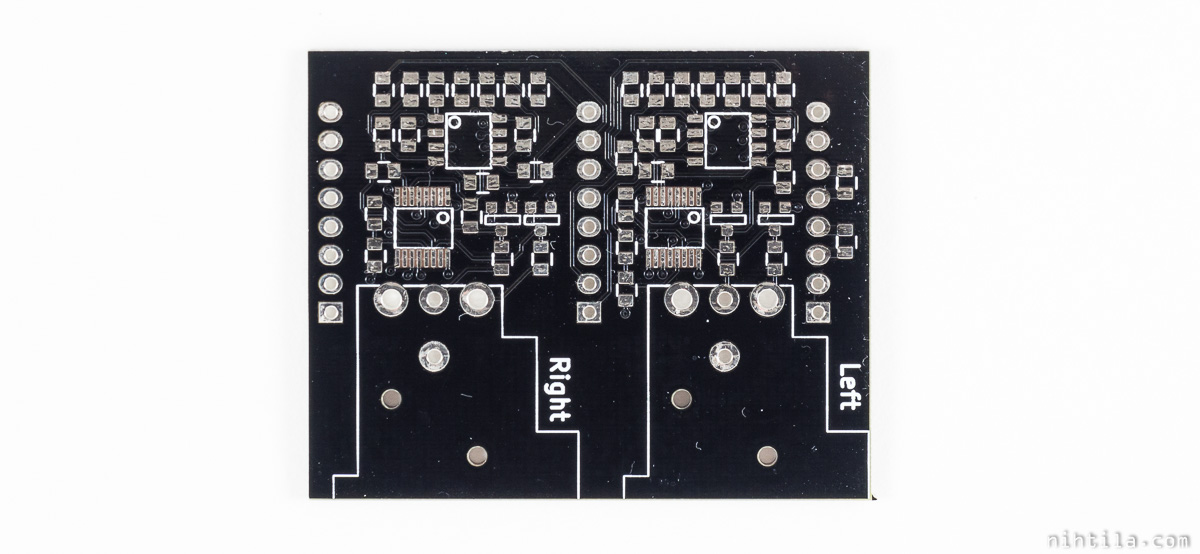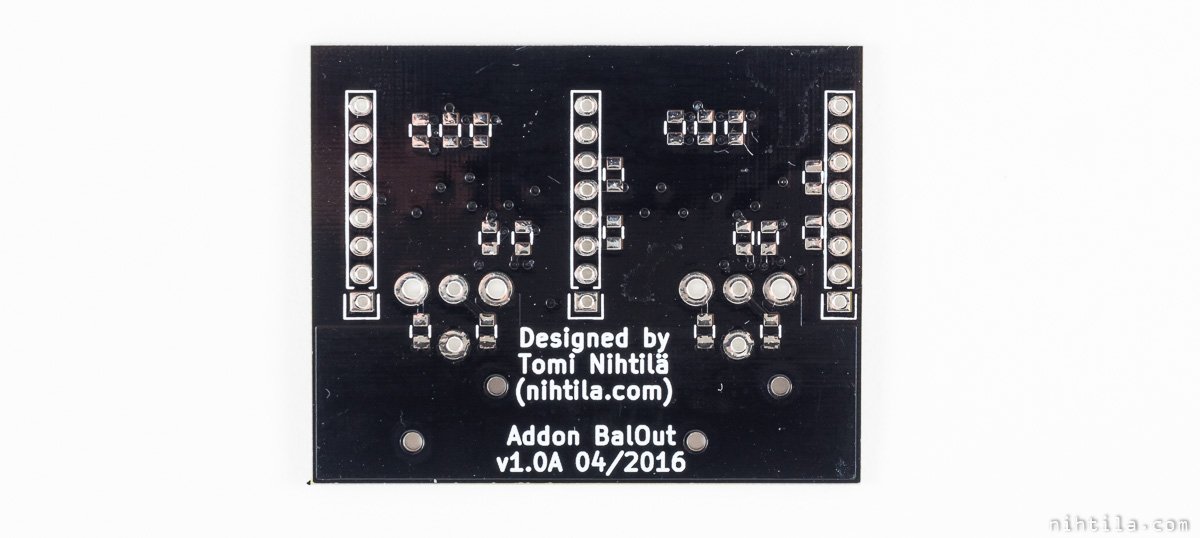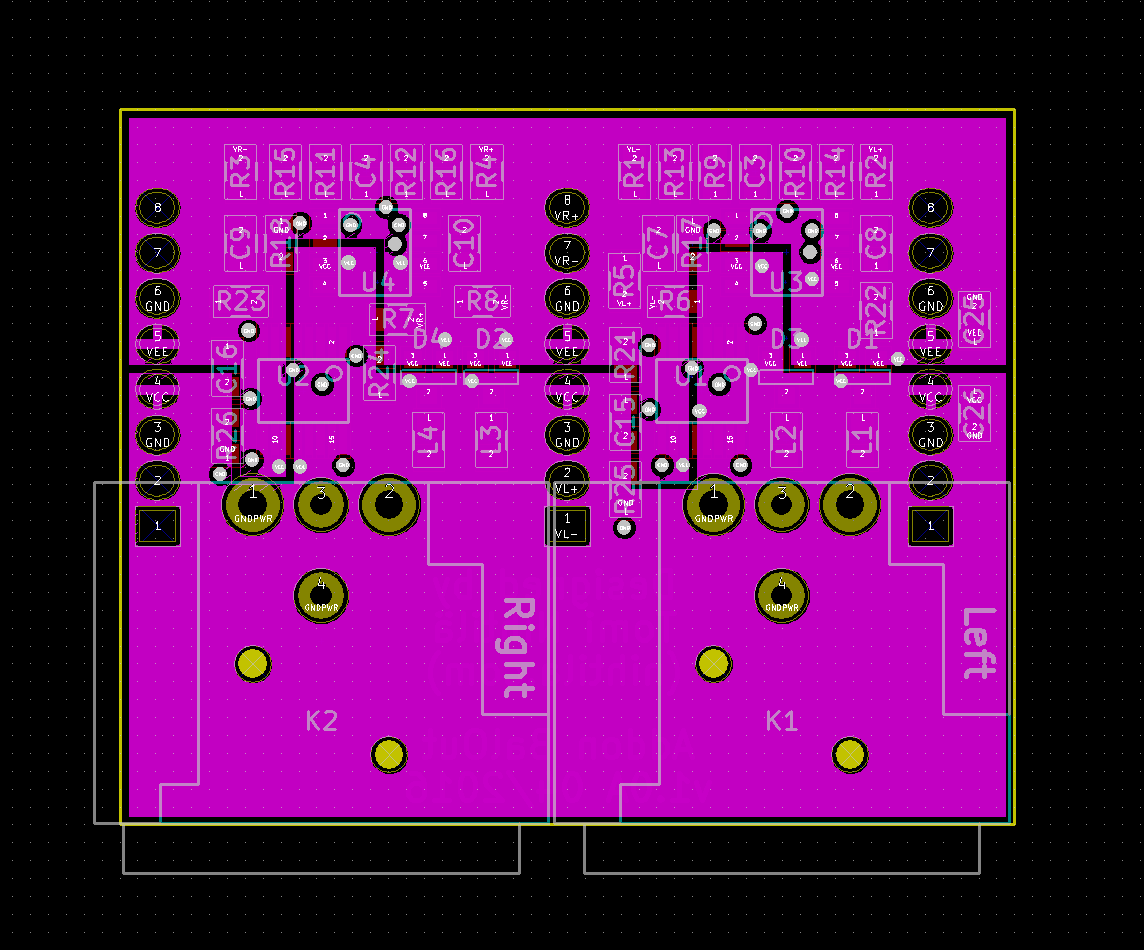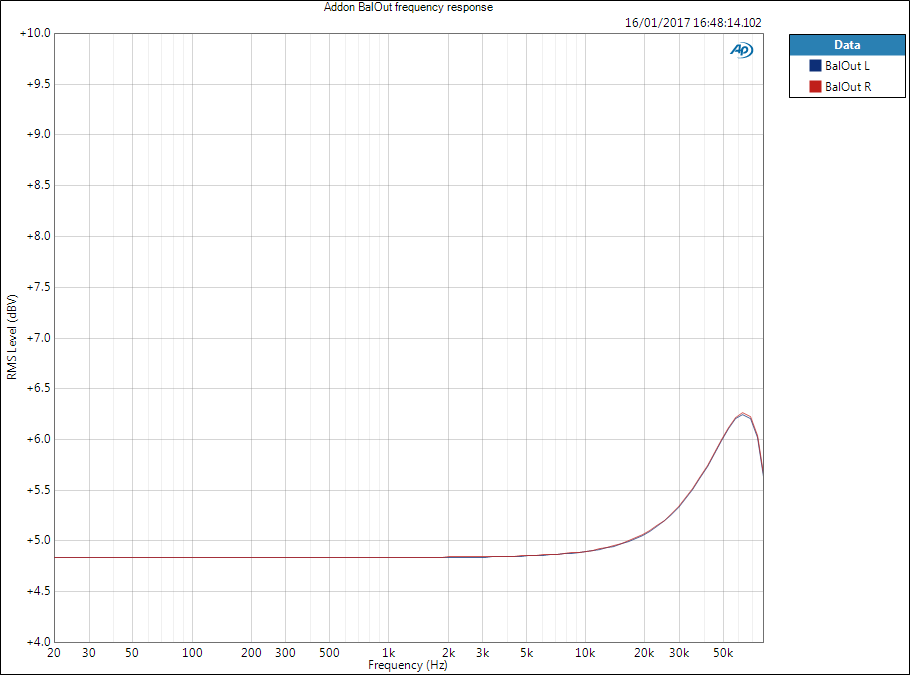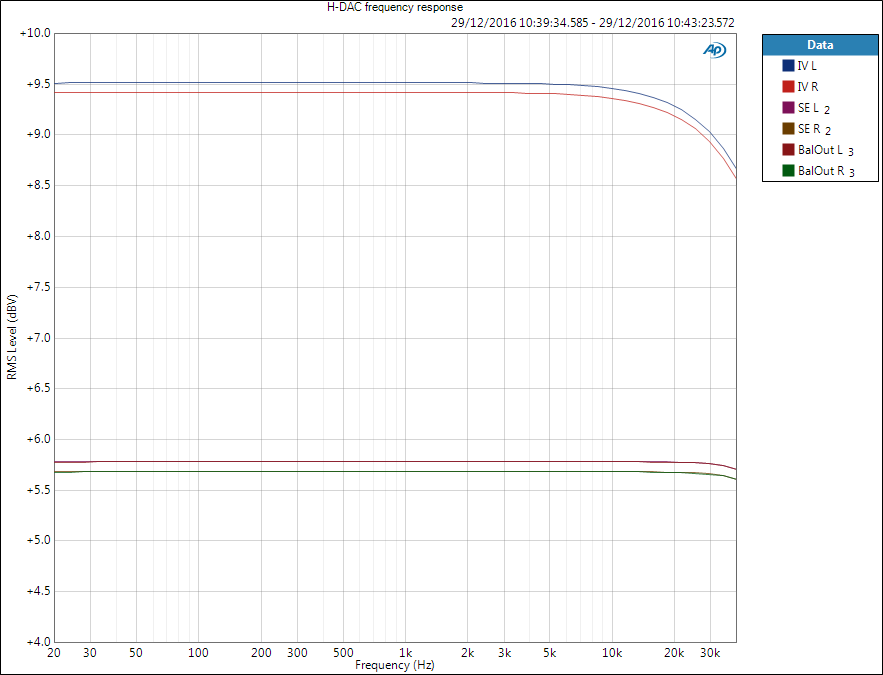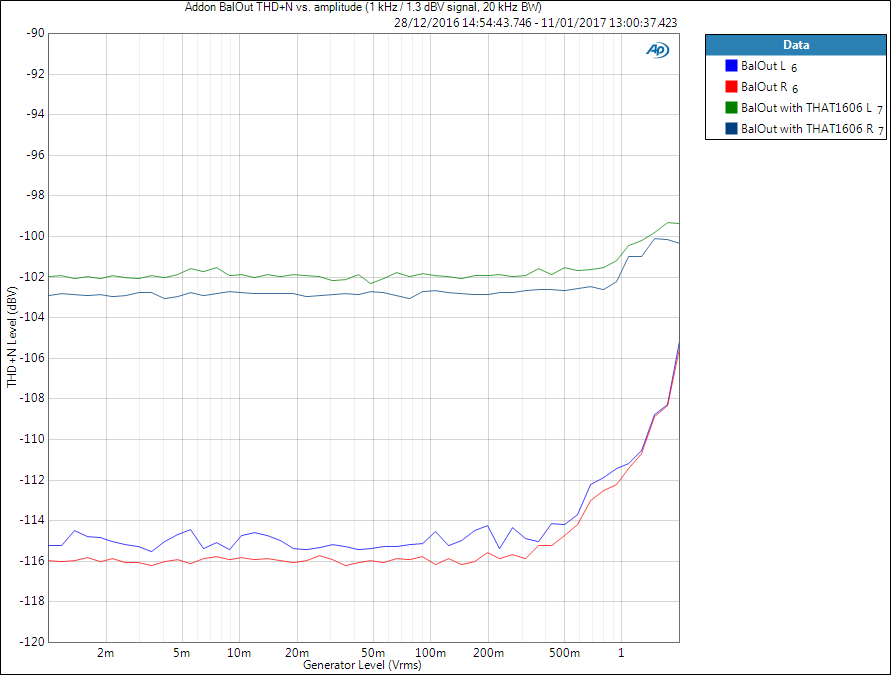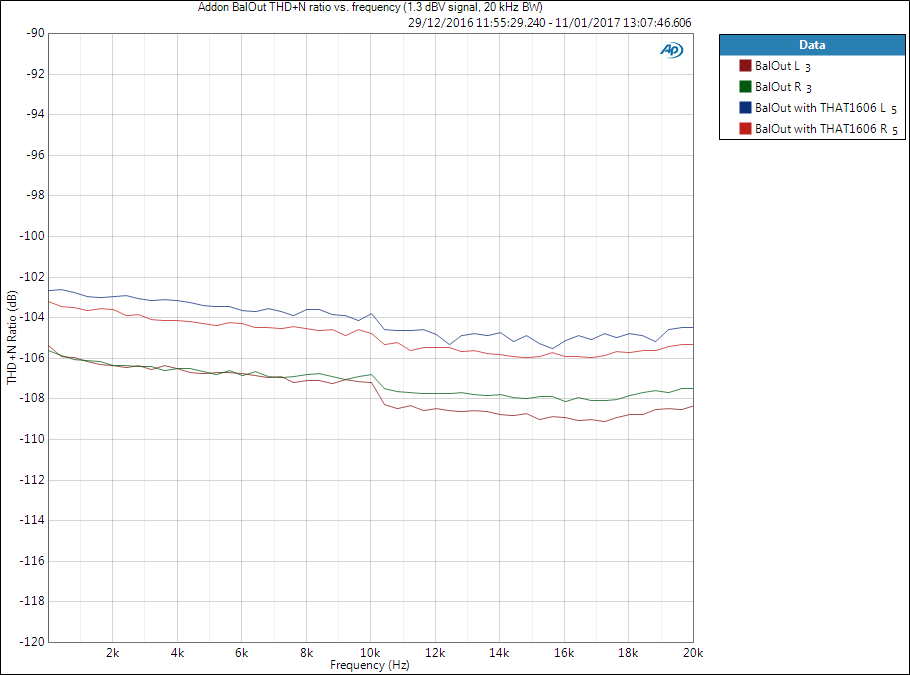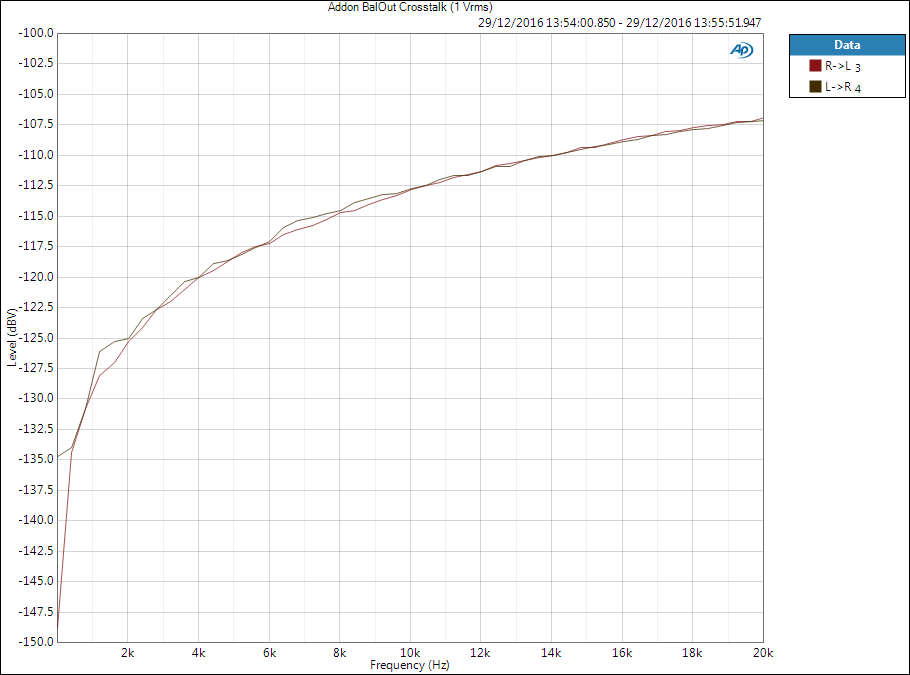- Very high performance; does not become bottleneck of H-DAC system
- Noise level: -117 dBV (A-weighted)
- THD+N ratio at 2 Vrms output signal: better than 109 dB
- Crosstalk at 10 kHz: 113 dB
- Balanced output buffer with low-pass filter
- Optional high-CMRR balanced drivers
- Takes power and audio signals directly from H-DAC
- 5×4 cm 4-layer PCB, LM49724 opamps (or any with the same pinout), optional THAT1606 balanced drivers
Addon BalOut is a small addon board to be stacked on H-DAC to add balanced XLR outputs. It works along with the unbalanced RCA outputs on H-DAC and audio performance is high enough not to be the limiting factor of the H-DAC system.
Design and schematics
Schematics consist of three blocks: differential buffer, optional balanced driver, and protection and filter components.
Differential buffer removes common mode DC voltage and filters out high frequency components after DAC; it is basically the same filter circuit as in H-DAC single-ended output stage but in differential configuration. Component values are the same as it forms a third order filter together with the I/V-stage in H-DAC. Therefore, if signal level or filtering frequency is to be changed, the whole third order filter must be considered. This can be done with a help of the instructions, component calculator, and LT Spice simulation files in H-DAC page (these files are for single-ended filter design but differential is just the same filter copied for positive and negative signals).
THAT1606 balanced driver offers very high CMRR (Common Mode Rejection Ratio), in a way trying to mimic “the real” balanced driver by transformer. This can offer significant benefits in noise and interference suppression in professional environment with long interconnects and hostile EMC-environment. However, as can be seen in the measurements section (and also in THAT1606 datasheet), its performance in terms of THD+N and especially noise level is significantly weaker than the rest of the components in H-DAC + Addon BalOut system. Therefore, if high CMRR is not specifically required, THAT1606s can be bypassed with resistors R21-R24, also acting as series resistors for differential buffers.
Protection and RF filter components are suggested in the THAT1606 datasheet and placeholders are added for these optional components. In the measured prototype these are not used. L1-L4 should be shorted with 0-ohm resistors if ferrites are not used.
Components
The design relies mostly on 0805-sized SMD components. All components are ‘basic’ ones, nothing exotic. Resistors are thin film type, filter capacitors film, and all other small capacitors ceramic.
Note that in the image below I have used 1206-sized decoupling capacitors directly on pinheaders P1, P2, and P3, as the footprints are for 0805 and I did not have the correct size caps at hand.
Layout
PCB is 4-layer with the following stackup: signals, ground, split power, and signals. Layout design is not described in detail. This design is quite simple but as it is also small, 4-layer board was used.
Below are layout images
Measurements
Audio measurements were performed with Audio Precision APx585 using external +12/-12 V supply. Measurements are done without THAT1606 balanced drivers unless otherwise mentioned. These measurements are done on Addon BalOut in isolation, not stacked on H-DAC.
Key figures (left/right channel):
- A-weighted noise level (20 kHz bandwidth):
- Without THAT1606: -117/-118 dBV
- With THAT1606: -104/-105 dBV
- THD+N ratio at 2 Vrms / 1 kHz output signal (20 kHz bandwidth):
- Without THAT1606: better than -109 dB (this is the distortion figure of the measurement instrument)
- With THAT1606: -105/-106 dB
- Crosstalk: 128 dB at 1 kHz, 113 dB at 10 kHz
- Current consumption:
- Without THAT1606: 17 mA per supply
- With THAT1606: 26 mA per supply
Note that THAT1606 has 6 dB gain, therefore signal level with it is rather high 12 dBV, or 4 Vrms.
Frequency response
Frequency response of Addon BalOut alone is shown below. High frequency boost is due to the fact that Addon BalOut is not designed to be used on its own; the second order filter is part of the third order filter formed by H-DAC I/V-stage and Addon BalOut.
Below is H-DAC frequency response: I/V-stage (top curves), and single-ended (RCA outputs) and Addon BalOut (XLR outputs) which are identical. It can be seen that as I/V-stage has first order low-pass filter, its response starts to roll-off already at audio band. Therefore, the filter stages in BalOut (or in single-ended stage of H-DAC) compensate this roll-off by boosting higher frequencies. These together form a third order maximally flat (Butterworth) filter. The overall output response of single-ended and BalOut are indentical (lower curves) and flat within the audio band.
THD+N vs. amplitude
THD+N vs. amplitude curve at 1 kHz is shown below with measurement bandwidth of 20 kHz and output signal level 1.3 dBV. There is around 1 dB difference between channels but noise floor is around -115…-116 dBV (A-weighted -117/-118 dBV). Note that x-axis is generator level but as BalOut has a gain of 0.65, output voltage is 0.65 times the generator level. When distortion starts to dominate, the source of that is in fact the measurement instrument.
Here it is very clear that noise performance of THAT1606 is significantly weaker than LME49724 opamp. However, it is still good to remind that we are dealing with noise level of around 8 micro-volts.
THD+N ratio vs. frequency
Note that this is a ratio between the output level and THD+N level, while the graph above is absolute level. This was measured with 1.3 dBV output signal level and 20 kHz measurement bandwidth.
THAT1606 does not lose as much here, or at least it cannot be measured when the opamp performance is likely limited by the measurement instrument.
Note: Why did I use 1.3 dBV signal level in the above measurements? Well, I somehow thought I was using 2 Vrms – the same as H-DAC output level. Instead, I had 2 Vrms generator voltage. However, as the resistor values on BalOut are so small, this loads the APx output which has source impedance of 100 ohms. Moreover, the gain of BalOut is actually negative: -3.5 dB. All this leads to output level of 1.3 dB and I didn’t bother measuring again as it does not really matter. After all, I am not lucky enough to have Audio Precision at home.
Crosstalk
Signal ‘leaking’ between channels can be quantified by crosstalk measurement, seen below.
To show where THAT1606 is good at I should measure CMRR. I may do that one day when I just think about how I should measure it.
Protection components
I quickly checked THD+N vs. amplitude, THD+N vs. frequency, and crosstalk with BAV99 protection diodes, ferrites, and 100 pF capacitors populated at the output. I did not see any differences in the measurements. Therefore, from signal quality perspective it should be safe to use these components.
Conclusion
Measurement results are good. There is slight difference between channels. To be honest, I was expecting to hit the noise floor of the measurement instrument which is -118 dBV (non-weighted) but did not quite get there. For some reason my measurement setup was also picking noise easily, I may try to figure out the root cause for that at later time.
After all, this module is not designed to be used on its ow. All that matter is that it does not restrict the performance of H-DAC.
Update: I have measured BalOut also with OPA1632 instead of LME49724 and created a separate post for that.
Files
v1.0A PDF files:
- Schematics
- Component placement top
- Component placement bottom
- BOM
- Check carefully before making component order
- Prices are in GBP, without VAT, and not up-to-date)
References
Version history
Schematics / PCB – known errors, bugs, and changes for next version
- v1.0A Initial version
- Change opamp footprint to have thermal pad – LME49724 has it
- Add signal labels on top silkscreen
- For 2.0 leave THAT1606 out; then due to simpler design:
- Keep differential pairs closer
- Use 2-layer board
- Change name to Addon H-BalOut for consistency
This page
- 6.1.2017 Initial version
- 16.1.2017 Added link to OPA1632 vs. LME49724 post
